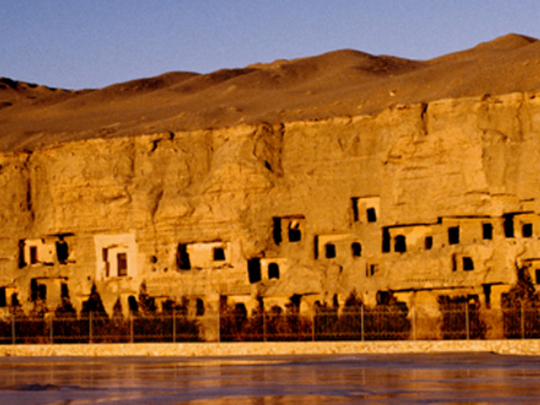
Dunhuang, China: At the heart of the ancient Silk Road, on the edge of the Gobi Desert, lies a centuries-old place of pilgrimage: hundreds of caves hewn from a sandstone cliff containing some of the most exquisite Buddhist frescoes and figures in the world.
Abandoned for centuries, the Mogao Grottoes somehow survived everything that nature and man could throw at them, including earthquakes, floods and sandstorms. Marauding rebels, plundering European explorers and White Russian soldiers all left their mark. Rampaging Red Guards were turned away at the height of China’s Cultural Revolution.
Today, the caves outside Dunhuang, in western China, enjoy a new stature, at the heart of Communist China’s efforts to revitalise and rebuild the Silk Road as a testament to its growing power in Asia. They also stand as a symbol of Sino-American cooperation in China’s cultural preservation, thanks to pioneering work by the Getty Conservation Institute.
But the fragile wall paintings, some of which date to the 4th century and show stories from Buddha’s life, face another threat — from a new army of tourists and the lure of profit.
“In the past 100 years, most of the damage has been done by nature, but visits by more tourists will break the original balance inside the caves,” said Wang Xudong, president of Dunhuang Academy, which runs, preserves and restores the site.
People problem
“Constant entrance and exit changes the temperature and humidity inside the caves. Human bodies also carry microorganisms, and if they start to grow inside the caves, it would be very scary.”
More than 1.1 million tourists visited the caves in 2015, a rise of 40 per cent in just a year and a roughly 20-fold jump in the past two decades.
The vast majority are Chinese, as the country’s growing wealth fuels a huge boom in domestic tourism and as interest is renewed in China’s Buddhist past.
With advice from Getty’s experts, the Dunhuang Academy initially tried to cap the number of tourists at 3,000 a day but later realised “that limit just would not stop people from coming,” Wang said. The limit was then raised to 6,000 a day, but demand regularly exceeds that in the peak July-to-October season.
To relieve the pressure, tourists are asked to register in advance and before visiting the site watch two 20-minute movies in a sweeping new visitors’ centre on the history of Dunhuang and the caves.
Later, they are guided through a selection of the 40 caves that are open to the public, forbidden to take photographs in case their camera flash damages the frescoes.
Register too late, above the 6,000 cut-off, and you’ll miss the movies and get to see only four caves. By giving these latecomers “a very bad experience,” Wang said he hopes to encourage more people to come during the low season, when ticket prices are halved.
The question is whether Wang can stem the tide. Beside the visitors’ centre, nine miles from the caves, construction workers are building a privately funded tourist complex, including a theatre and hotels.
In the city of Dunhuang, a $250 million (Dh918 million) conference centre and a bigger, 2,000-seat theatre are being built to house an annual Silk Road Cultural Expo. The airport is being expanded, with a $150 million upgrade.
Money pressure
“There is enormous commercial pressure,” said Neville Agnew, who has been visiting and working in the caves for 28 years for the Getty Conservation Institute. “The growth of the city of Dunhuang depends ultimately on the Mogao Grottoes. They are going to have their work cut out to control visitation ...”
Yet there is also state-of-the-art restoration work going on here, thanks to a long-standing collaboration between the Dunhuang Academy, Getty and other foreign experts.
Painstakingly, the restorers start in each cave by taking hundreds of high-resolution photographs, in colour and black-and-white. Then the frescoes are examined to see what materials were used — and the causes of deterioration diagnosed — before experts decide on the best materials and methods to restore them.
The project has produced guidelines that have been applied to other grottoes across China as well as principles that have helped the country better manage its heritage sites. It has also spawned a major new exhibition at the Getty Research Institute in Los Angeles that runs until September and includes full-size replicas of three of the caves.
It is a much happier example of Sino-Western collaboration than the caves experienced a century ago. In 1907, Hungarian British archaeologist Aurel Stein persuaded a local monk to sell him 24 trunks packed with ancient Buddhist scriptures and five trunks of paintings, embroideries and other artworks that had only recently been discovered in a small walled-up cave. He paid the equivalent of £130 (Dh695).
French, Japanese and Russian explorers took thousands more priceless documents in subsequent years before American Langdon Warner showed up in 1923 to find the portable treasures gone. Determined not to leave empty-handed, he took some of the sculptures and used adhesive glue to rip a dozen paintings off the walls.
Today, 735 caves remain, hewn from the cliff over a period of 1,000 years. Nearly 500 have paintings on the walls — undecorated caves were for meditation — while more than 2,000 sculptures have survived.
— Washington Post












